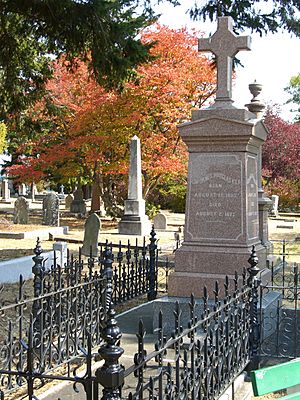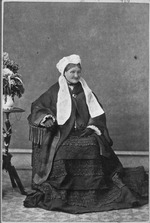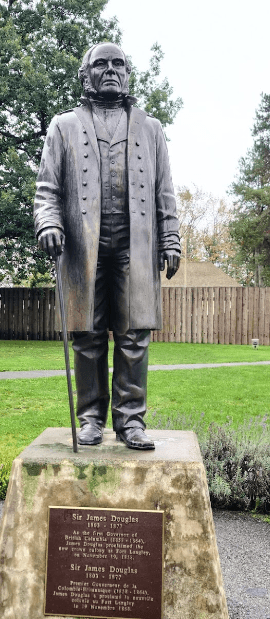James Douglas (governor) facts for kids
Quick facts for kids
Sir James Douglas
|
|
|---|---|

James Douglas with Order of the Bath honours
|
|
| Governor of British Columbia | |
| In office 1858–1864 |
|
| Succeeded by | Frederick Seymour |
| Governor of Vancouver Island | |
| In office 1851–1864 |
|
| Preceded by | Richard Blanshard |
| Succeeded by | Arthur Edward Kennedy |
| Personal details | |
| Born | August 15, 1803 Demerara, Dutch/Batavian Colony of Essequibo |
| Died | August 2, 1877 (aged 73) Victoria, British Columbia |
| Resting place | Ross Bay Cemetery |
| Political party | None |
| Spouse | Amelia Douglas |
| Parents |
|
Sir James Douglas KCB (August 15, 1803 – August 2, 1877) was an important leader in the early history of British Columbia. He was a fur trader and a politician. He became the first Governor of the Colony of British Columbia. Many people call him "The Father of British Columbia" because of his important work.
Douglas helped about 35 African-Americans find a new home in British Columbia. They were escaping unfair treatment in San Francisco. They arrived on a ship called the Commodore. This event became known as The Pioneer Committee. In 1863, Queen Victoria made Douglas a knight for his great work for the British Crown.
He started working at age 16 for the North West Company. Later, he worked for the Hudson's Bay Company and became a high-ranking officer. From 1851 to 1864, he was Governor of the Colony of Vancouver Island. In 1858, he also became the first Governor of the Colony of British Columbia. He made sure that British rule was strong during the Fraser Canyon Gold Rush. This helped prevent the Mainland from becoming part of the United States. He was governor of both colonies until he retired in 1864.
Contents
Early Life and Fur Trade Career
Douglas was born in 1803 in Guyana. His father, John Douglas, was a Scottish merchant. His mother, Martha Ann, was a free person of mixed African and European background. They had three children together, but they never formally married.
In 1812, John Douglas took James back to Scotland for school. James also studied in Manchester, England. There, he learned to speak and write French very well. This skill helped him a lot later in North America.
Joining the North West Company
At 16, James Douglas joined the North West Company (NWC). This was a big company involved in the North American fur trade. He sailed from Liverpool to Lachine, Lower Canada, in 1819. Douglas started as a clerk at Fort William.
The next year, he moved to Île-à-la-Crosse in what is now northern Saskatchewan. Douglas kept learning on his own by reading books. He also met many First Nations people, which helped him understand the land and its people.
Working for the Hudson's Bay Company
In 1821, the NWC joined with its rival, the Hudson's Bay Company (HBC). Douglas continued his work with the HBC and quickly moved up the ranks. In 1825, he helped set up the Fort Vermilion trading post in Alberta. He then moved to Fort St. James in the New Caledonia District, which is now part of British Columbia.
In 1827, Douglas built Fort Connolly. It was named after his boss, William Connolly. Connolly was very impressed with Douglas. Because they were close, Connolly agreed to Douglas marrying his Métis daughter, Amelia Connolly. Her mother was Cree. Douglas and Amelia married in 1828 in a traditional way. They had another ceremony almost ten years later.
In 1828, Douglas was in charge of Fort St. James. During this time, two company traders were killed. Douglas was involved in dealing with the accused. The exact details are debated, but Douglas gained a tough reputation among local First Nations.
To keep Douglas safe, Connolly asked for him to be moved. Douglas was sent to Fort Vancouver. This was the main base for the HBC's Columbia District. His wife joined him there. They had ten more children while living at Fort Vancouver. Their son, James W. Douglas, later became a politician.
Life at Fort Vancouver
Douglas worked at Fort Vancouver for 19 years. In 1835, he became a Chief Trader. This was the second-highest rank in the HBC. In 1838, Douglas was put in charge of the Columbia District. While leading Fort Vancouver, he spoke out against the enslavement of Chinookan peoples.
Douglas also helped with plans to work with the Russian-American Company (RAC). The RAC-HBC Agreement allowed the HBC to rent land in Russian American claimed territory. This land was in what is now Alaska. In return, the RAC received furs and supplies. To meet these needs, the Pugets Sound Agricultural Company (PSAC) was created. It helped supply the Russians and encouraged settlement around Cowlitz Farm and Fort Nisqually in present-day Washington.
In 1839, Douglas was promoted to Chief Factor. This was the highest rank for field service. He traveled to Alta California and got permission to build a trading post in Yerba Buena, California (now San Francisco). In 1841, Douglas was asked to set up a trading post on Vancouver Island. This was a backup plan in case the Columbia River area became American. Douglas founded Fort Victoria, where Victoria, British Columbia is today. This was a good decision. In 1846, the Oregon Treaty set the border between British North America and the United States along the 49th parallel.
Governor of Vancouver Island

In 1849, Britain leased all of Vancouver Island to the HBC. The condition was that a colony had to be created. Douglas moved the HBC's western headquarters from Fort Vancouver to Fort Victoria.
Douglas was not the first Governor of the Colony of Vancouver Island. That job went to Richard Blanshard. However, Douglas had most of the real power because he controlled the money and land. He effectively made Blanshard leave the position. Douglas respected the Royal Proclamation of 1763. He made it a policy to trade with First Nations for their land.
Land was usually bought with blankets. This policy also helped keep good relations with First Nations and avoid violence. After Blanshard resigned in 1851, the British government appointed Douglas as Governor of Vancouver Island. He was still a Chief Factor for the HBC. For several years, he tried to manage both important jobs. He faced criticism in local political discussions.
As governor, Douglas faced many challenges. One big challenge was the growing power of the United States next door. Douglas used his limited resources to create the Victoria Voltigeurs. This was Vancouver Island's first militia. He also used the Royal Navy for protection. During the Crimean War, British and French soldiers were sent to Victoria. Douglas was asked to build a hospital at Esquimalt harbour. This base became very important.
In 1859, Douglas's colony had a disagreement with Washington Territory. This was about who owned the San Juan Islands. This long argument was called the Pig War. Douglas wanted Britain to claim all the islands. The San Juan Islands were very close to Victoria and important for defense. The dispute was eventually settled, and the islands went to the United States.
Douglas's biggest challenge in the 1850s was dealing with the many First Nations peoples. There were about 30,000 First Nations people in the area. In contrast, there were fewer than 1,000 Europeans in the Colony. In nearby Oregon and Washington Territory, there were many conflicts between Americans and Indigenous peoples.
Douglas had mixed relations with First Nations. His wife was Cree, and he had good business ties with Indigenous peoples as a fur trader. He also tried to make treaties with First Nations on southern Vancouver Island. These were called the Douglas Treaties. However, he also supplied arms to the US government in their conflicts with Native American tribes. The treaties he made were later criticized for not giving enough compensation to First Nations for their land. The treaties were made between 1850 and 1854. They bought 14 pieces of land for the Crown. Treaty-making stopped when the Colony ran out of money.
Douglas also helped start public elementary schools. He also built the Victoria District Church. In 1856, the British Government asked Douglas to create an elected Legislative Assembly. This was a big change for Douglas, who was used to having total control. The assembly often disagreed with Douglas. They criticized him for having a conflict of interest between his duties to the company and to the colony.
The Fraser Canyon Gold Rush
In 1856, gold was found in the Thompson River. A year later, gold was found in the Fraser River. This news spread to the United States. Thousands of miners from America came to British Columbia during the Fraser Canyon Gold Rush. Douglas did not have official power on the mainland. But he worked to make sure British law was followed. He sent a warship to the mouth of the Fraser River. It issued licenses to miners and merchants.
A major task was to prevent fighting between the new arrivals and the local First Nations. In the fall of 1858, tensions grew between miners and the Nlaka’pamux people. This led to the Fraser Canyon War.
Douglas's actions helped keep control over the American miners. They also helped stop American plans to take over this part of British North America. Soon after, the British government officially made the mainland a new colony.
Governor of British Columbia
In August 1858, Douglas heard that two miners had been killed by First Nations people on Vancouver Island. He thought the whole region might go to war. He went to investigate. He found that alcohol was a big problem. He then banned selling alcohol to First Nations. Douglas also brought a lawyer with him to show that British law was still in effect. During his trip, he saw many foreigners settling on land without permission. This meant less money for the government.
To stop illegal acts, Douglas appointed local police officers. He also created Assistant Gold Commissioners. These officials handled mining and legal cases. These steps helped prevent the chaos that happened during the California Gold Rush from happening in British Columbia.
In December 1861, during the Trent Affair, Douglas suggested that Britain should invade Washington Territory. He thought America was too busy with the Civil War. He believed there were few US troops or ships in the area. He said the Royal Navy could easily take control. He argued that if Britain held Puget Sound and the Columbia River, they would control the trade and make the area submit to British rule.
Douglas continued his work as governor. He ordered the building of government offices in 1859. In 1862, rich gold was found in the Cariboo region. This started the Cariboo Gold Rush. Douglas ordered the building of the Cariboo Road. This amazing road was 400 miles long. It went from Fort Yale to Barkerville through dangerous canyon land. It was also called the "Queen's Highway."
Near the end of his time as governor, Douglas was criticized. Some felt he was not developing the colony into a self-governing body. His only political change had been to start an elected Legislative Council. He argued that most people in the colony were not British subjects. Also, few owned property, so they were not ready for self-governance.
Douglas was friends with Robert Ker, the first Auditor General. He was also friends with John Sebastian Helmcken. Helmcken later became a Speaker of the House. Both Ker and Helmcken are seen as founding fathers of British Columbia. Helmcken married Douglas's daughter, Cecilia.
Retirement and Death
When Douglas retired from his service to the Empire, Queen Victoria made him a Knight Commander of the Order of the Bath. He was honored with banquets in Victoria and New Westminster. He also received a thank you letter signed by 900 people. In 1864 and 1865, Douglas traveled around Europe. He visited family in Scotland and Paris. He had to return early when his daughter, Cecilia, passed away.
Douglas remained active but stayed out of politics. He died in Victoria from a heart attack on August 2, 1877, at age 73. His funeral was one of the largest in British Columbia's history. He was buried in the Ross Bay Cemetery.
Places Named for Douglas

Many places in British Columbia are named after Sir James Douglas:
- Port Douglas, British Columbia: A former community on Harrison Lake.
- The Douglas Ranges: Mountains west of Harrison Lake.
- The Douglas Road: An important wagon road from Harrison Lake to Lillooet.
- Douglas: A Canada-US border crossing in Surrey, British Columbia.
- Douglas Peak: A 1,486-metre (4,875 ft) mountain on the Vancouver Island Ranges.
- Mount Douglas: A 260-metre (850 ft) hill in Saanich. A high school, park, and businesses are also named after it.
- Douglas Channel: A 90-kilometre (56 mi) inlet on British Columbia's northwest coast.
- Douglas Inlet: On the west side of Moresby Island in Haida Gwaii.
- Douglas Road: An old road connecting New Westminster to Burrard Inlet.
- Douglas Street: A major road in Victoria.
- Douglas College: A public college with campuses in New Westminster and Coquitlam.
- Sir James Douglas Elementary School and Sir James Douglas Annex: Public elementary schools in South East Vancouver.
- Sir James Douglas Primary School: In Supply, Mahaica, Demerara, Guyana.
- Many other schools across British Columbia are named after him.
- James Island: A 315-hectare (780-acre) island east of the Saanich Peninsula.
- James Bay: A small bay in Victoria Harbour. The historic neighborhood around it was once Douglas's property.
- Douglas Hall: A residence hall at Trinity Western University in Langley, BC.
- Douglas Portage: A route around the "Falls of the Fraser" between Spuzzum and Yale.
| Preceded by John McLoughlin |
Chief Factor of Hudson's Bay Company 1840–1858 |
Succeeded by A.G. Dallas |
| Preceded by Richard Blanshard |
Governor of Vancouver Island 1851–1864 |
Succeeded by Arthur Edward Kennedy |
| Preceded by Position Nonexistent |
Governor of British Columbia 1858–1864 |
Succeeded by Frederick Seymour |



